ISSN ONLINE(2319-8753)PRINT(2347-6710)
ISSN ONLINE(2319-8753)PRINT(2347-6710)
Jagadeesh Sannagoudra 1, G.Manavendra 2, S.Kumarappa3
|
| Related article at Pubmed, Scholar Google |
Visit for more related articles at International Journal of Innovative Research in Science, Engineering and Technology
In a modern day world alternative source of energy are given importance due to gradual depletion of fossil fuels reserves vegetable oils can be used as an alternative to diesel in CI engines. The use of vegetable oils in CI engine results in low CO and HC emissions compared to conventional diesel fuel. The present study covers the various aspects of biodiesels fuel derived from cottonseed oil and neemseed oil. Cottonseed oil and neemseed oil are converted to Cottonseed oil Methyl Esters (CSOME) and Neemseed Oil Methyl Esters (NOME) by transesterification process. Experimental investigations were carried out on single cylinder diesel engine with Bio Diesel blends of Cottonseed oil Methyl Esters and Neemseed Oil Methyl Esters. Various Tests have been carried out to examine properties, combustion, performance and emission characteristics of the engine for different blends of CSOME and NOME. Base data was generated for diesel first and subsequently, it was replaced by the Bio diesel and both the results were compared and discussed
Keywords |
| Bio-diesel, Transesterification, cottonseed oil methyl Ester (CSOME), Neem oil methyl ester (NOME), Injection pressure, CSOME 20% (C20), NOME 20% (N20), CSOME10%+NOME10% (C10+N10). |
INTRODUCTION |
| Worldwide petroleum consumption has steadily increased. In 2009, the total consumption was 4,060 million tons, with an average annual growth rate of about 1.5 % in the past 20 years. As a result, crude oil is becoming scarcer, more expensive and a highly volatile commodity. According to BP’s annual statistical review of world energy, the proven oil reserves were estimated at 1.7 X 105 million tons in late 2008, with a reserve to production ratio of 42 years. Today, the transportation sector worldwide is almost entirely dependent on petroleum-derived fuels. Petroleum-based products are one of the main causes of anthropogenic carbon dioxide (CO2) emissions to the atmosphere. One-fifth of global CO2 emissions are created by the transport sector, which accounts for some 60% of global oil consumption. Around the world, there were about 806 million cars and light trucks on the road in 2007. These numbers are projected to increase to 1.3 billion by 2030 and to over 2 billion vehicles by 2050. This growth will affect the stability of ecosystems and global climate as well as global oil reserves. |
| There are different types of Biodiesels are available such as Sunflower, Soya bean, Cottonseed, Linseed, Mahua, Jatropha, Pongamia, Neemseed, Rapeseed etc. The present work is to investigate the evolution of Cotton seed and Neem seed oils with Diesel. |
A. Present Work |
| The present research is aimed at exploring technical feasibility of Cottonseed oil, Neemseed oil in Single Cylinder Diesel Engine without any substantial hardware modifications. In this work the Performance analysis, emission analysis, combustion analysis of diesel, CSOME, NOME are investigated with varying injection pressure (from 210 to 290 bar). Fuel properties of diesel, CSOME, NOME and cottonseed and neemseed oils are evaluated. |
B. Objectives |
| 1. FFA content of crude oil is to be determined to select the type of trans-esterification process. |
| 2. Methyl esters of Cotton seed and Neem seed are produced by suitable trans-esterification process. |
| 3. Evaluation of the properties of Biodiesel prepared |
| Following properties are to be evaluated |
| a. Kinematic Viscosity |
| b. Flash Point and Fire Point |
| c. Density |
| d. Calorific Value |
| Following Performance, Exhaust emission and combustion characteristics are to be evaluated |
| a. Brake power. |
| b. Brake specific fuel consumption. |
| c. Brake thermal efficiency. |
| d. Exhaust gas temperature. |
| e. Emission of CO, NOX, HC. |
| f. Combustion analysis. |
METHODOLOGY |
A. Selection of Transesterification Process |
| There are two approaches/processes for the production of bio diesel. The criteria for selecting the process is based on the presence of Free Fatty Acid (FFA) content in the oil. |
| 1. If the FFA content in the oil is less than 4%, Single stage (Alkali based) process has to be undertaken. |
| 2. If the FFA content in the oil is more than 4%, Double stage (Acid +Alkali based catalyst) process has to be undertaken. |
| Determination of FFA in raw oil: Prepare 0.1N NaOH solution, take 10ml of raw oil in a conical flask add few drops of indicator like phenolphthalein and shake well, Titrate against 0.1N NaOH and shake the conical flask mixing the mixture uniformly until a faint pink colour is obtained, Take the burette reading. |
 |
| FFA Content of cotton seed oil = 1.29% < 4% (Base catalyst process)` |
| FFA Content of neem seed oil = 4.906% > 4% (Acid-Base catalyst process) |
| After acid treatment: FFA Content of neem seed oil = 1.91% < 4% (Base catalyst process) |
| Single stage (Base catalyst process): Measure 1lt. of oil, transfer this oil into 3-neck flask and place on magnetic stirrer, fix the reflex condenser and switch ON the setup heating to 60°C, take 300ml methanol per lt. of oil, weigh the required NaOH based on FFA content and add to methanol. This mixture is called “methoxide” mixture maintain the temperature and allow the 2 hr. for reaction after 2hr stop the reaction transfer the mixture into separating funnel and allow so settle for 2hr, after 2hr glycerine will settle at bottom and biodiesel separates as top layer, Drain the glycerine layer. Double stage (Acid-Base catalyst process): Measure FFA of oil. Take 1lt. of oil transfer this oil into 3-neck flask and place on magnetic stirrer. Fix the reflex condenser and switch ON setup heating to 60° C add 150ml methanol and concentrated H2SO4 as per lab calculation agitate the mixture in the reaction vessel at 60°C for 2hr a dark layer is observed at the top layer of oil transfer the mixture into separating funnel and allow so settle for 2hr.Drain the acid layer transfer this oil into 3-neck flask. Repeat the single stage process. |
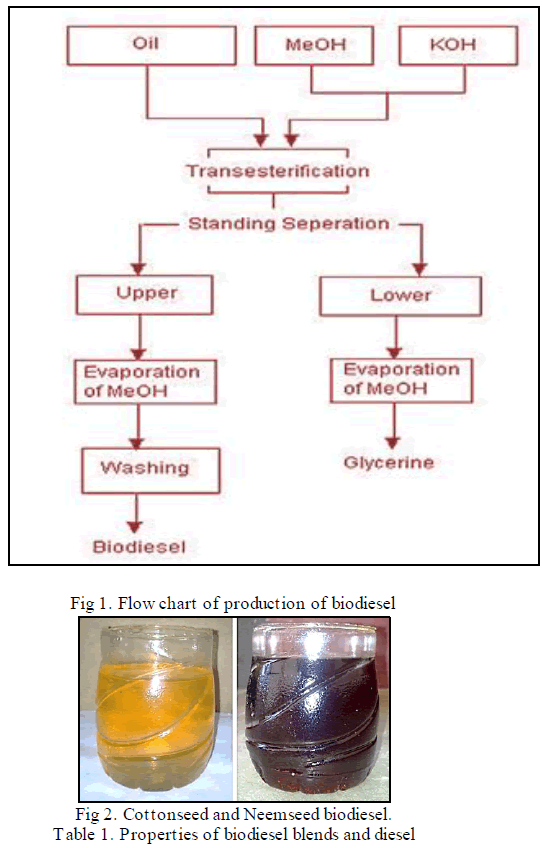 |
 |
B. Experimental setup |
| The performance of test fuels are analysed in a Kirloskar make single cylinder, four-stroke, direct injection diesel engine. The engine is coupled with an eddy current dynamometer. Experiments are conducted with varying loads and varying injection pressure starting from 210 bar to 290 bar with an interval of 40 bar, while engine speed was kept constant. Fuel flow rates are obtained with calibrated burette. The exhaust gas temperatures are measured using thermocouple. Parameters like brake specific fuel consumption and brake thermal efficiency are analysed for different load conditions. The emissions from the engine are measured after the engine reached the steady working condition. |
| The AVL make exhaust gas analyser is used to measure the carbon monoxide (CO), carbon dioxide (CO2), Hydro Carbon emission (HC) and Nitrogen Oxides (NOx). The experimental setup is shown in fig. 3, the AVL exhaust gas analyser shown in fig. 4 and the table. 2 shows the test engine specifications. |
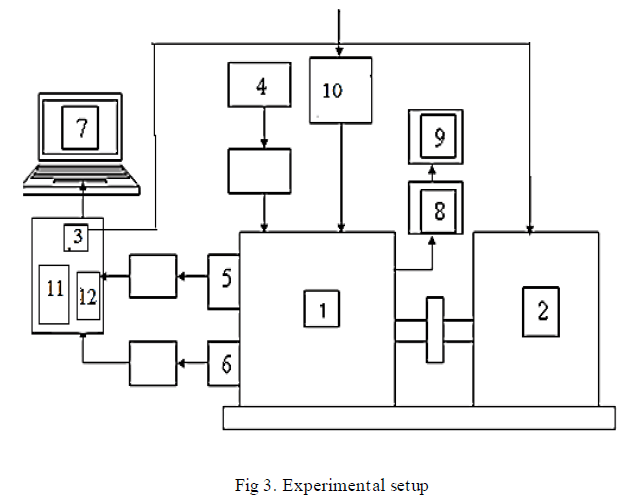 |
| 1. Diesel engine, 2. Alternator, 3. Load cell, 4. Fuel tank, 5. Pressure pickup, 6. Shaft encoder, 7. Computer, 8. Exhaust gas analyser, 9.Exhaust temperature measurement meter, 10. Speed sensor, 11. Fuel consumption meter, 12. Air flow measurement |
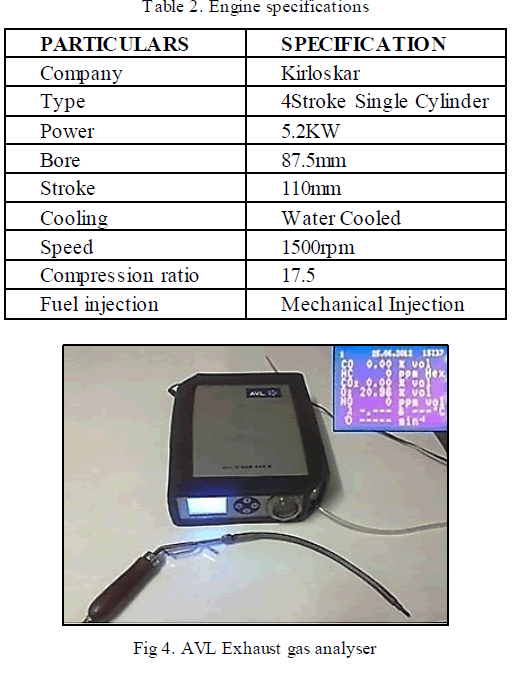 |
RESULT AND DISCUSSIONS |
A. Brake Specific Fuel Consumption |
| The fig 5. Shows variation of BSFC with BP for different blends. It can be seen that BSFC is decreased with increasing brake power due to high percentage of conversion of heat energy into useful work. BSFC of engine when run on neat diesel at an injection pressure of 210bar, speed of 1500 rpm and load of 3.5 KW is 0.29 kg/kWh. For C20 and C40 it is 0.31 kg/kWh and 0.318 kg/kWh, for N20 and N40 it is 0.31 kg/kWh and 0.32 kg/kWh, and for C10+N10 and C20+N20 it is 0.29 kg/kWh and 0.33 kg/kWh respectively. |
| B. Brake Thermal Efficiency |
| The fig 6. Shows variation of BTE with BP for different blends. Brake Thermal Efficiency of engine when run on neat diesel at an injection pressure of 210bar, speed of 1500 rpm and load of 3.5 KW is 29.361%. For C20 and C40 it is 28.86% and 27.557 %, for N20 and N40 it is 28.46 % and 27.12 %, and for C10+N10 and C20+N20 it is 28.12 % and 26.40 % respectively. |
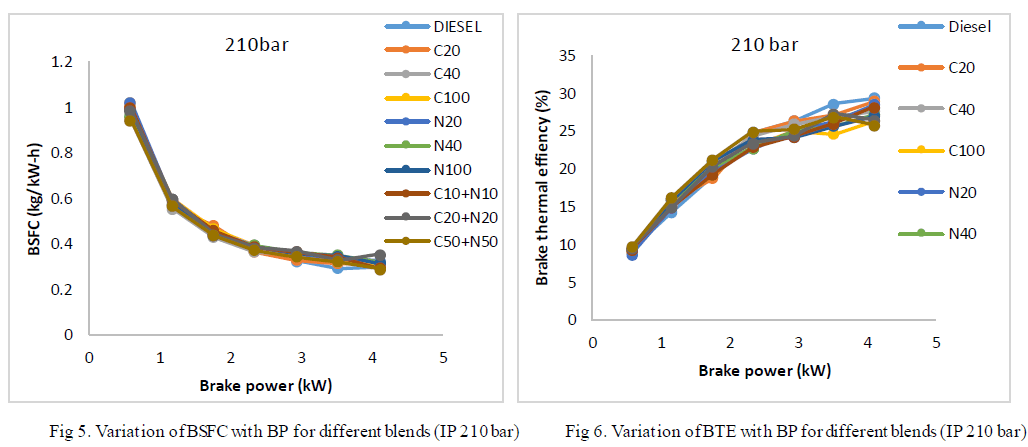 |
| C. Exhaust Gas Temperature (EGT) |
| The fig 7. Shows variation of exhaust gas temperature with BP for different blends. The exhaust gas temperature of engine when run on neat diesel at an injection pressure of 210bar, speed of 1500 rpm and load of 3.5 KW is 352°C. For C20 and C40 it is 382°C and 402°C, for N20 and N40 it is 364°C and 370°C, for C10+N10 and C20+N20 it is 365°C and 372°C respectively. |
| D. Hydrocarbon (HC) |
| The fig 7. Shows variation of unburnt hydrocarbon with BP for different blends. It is observed that at an injection pressure of 210bar, speed of 1500 rpm and load of 3.5 KW HC emission for diesel is 67ppm. For C20 and C40 it is 55ppm and 50ppm. For N20 and N40 it is 62ppm and 58ppm. For C10+N10 and C20+N20 it is 62ppm and 61ppm respectively. |
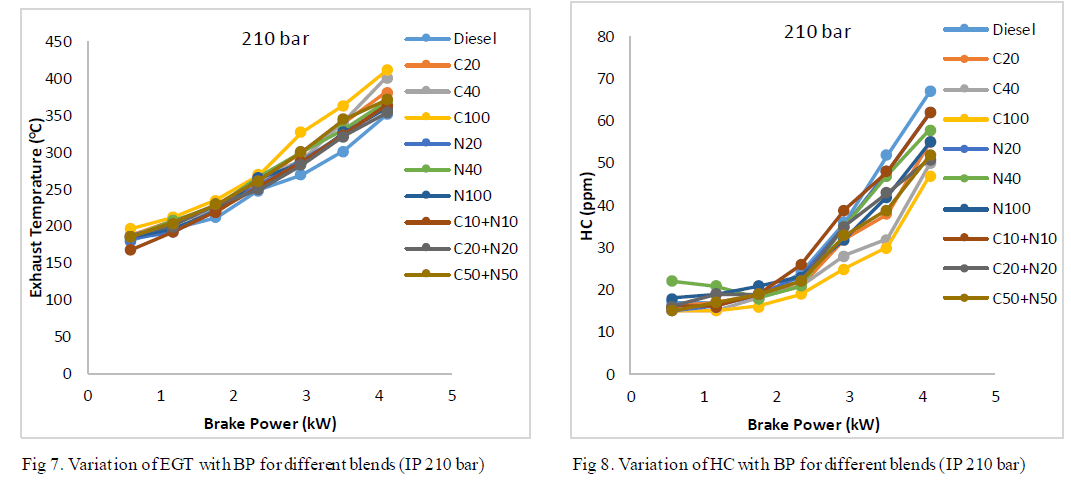 |
| E. Carbon Monoxide (CO) |
| The fig 9. Shows variation of carbon monoxide with BP for different blends. The biodiesel blends gives slightly lesser CO emission compared to diesel It is observed that at an injection pressure of 210bar, speed of 1500 rpm and load of 3.5 KW CO emission for diesel is 0.68%vol. For C20 and C40 it is 0.65%vol and 0.63%vol. For N20 and N40 it is 0.63%vol and 0.62%vol. For C10+N10 and C20+N20 it is 0.64%vol and 0.62%vol respectively. |
| F. Indicated mean effective pressure |
| The fig 10. Shows variation of IMEP with BP for different blends. Indicated mean effective pressure increases gradually with the increase in brake power. Indicated mean effective pressure of the bio diesel is little high than the diesel due to fact that blends burns more cleanly and results in complete combustion compared with diesel fuel. The maximum mean effective pressure can be observed for injection pressure 210bar at full load condition. |
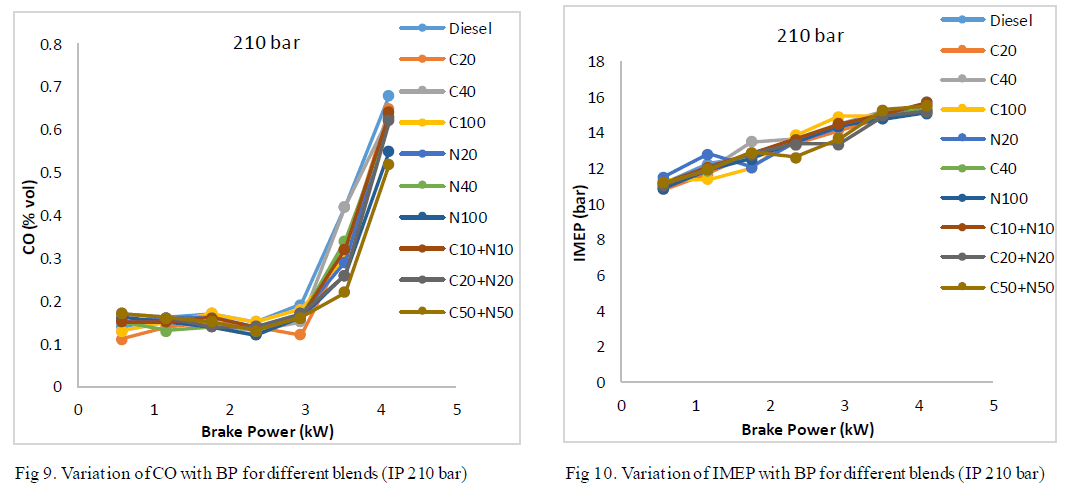 |
| G. Peak pressure rise |
| The fig 11. Shows variation of Peak pressure with BP for different blends. At injection pressure 210bar the diesel as higher cylinder pressure than bio diesel blends due lower Cetane number of bio diesel and higher Cetane number of diesel results in increased pressure inside the cylinder. But at lower injection pressure the pressure inside the cylinder is low due to improper mixing of fuel and air results in low cylinder temperature and pressure. |
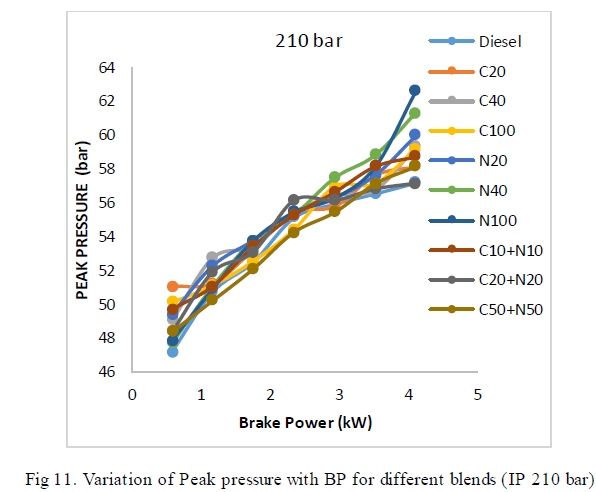 |
 |
CONCLUSION |
| In the present work, it has confirmed that Cottonseed and Neemseed oil may be used as resource to obtain the bio diesel. The CSOME and NOME along with diesel may reduce the environmental impacts of transportation and also reduce the dependency on crude oil imports, and also provide employments in agricultural field. The conclusions with respect to the performance, emission and combustion are summarized below. |
| The fuel consumption of the engine was somewhat higher at all loads and injection pressures for biodiesel blends due to lower gross heat of combustion. |
| When injection pressure is increased from 210 to 250 bar, For C20 the BTE is decreased by 19.71%, For N20 by 19.60%, For C10+N10 by 19.06%, and when injection pressure is increased from 250 to 290 bar the decrease or increase in BTE was insignificant. |
| The increase in injection pressure from 210bar to 250bar leads to decrease in brake thermal efficiency with increased brake specific fuel consumption. |
| Carbon monoxide are lower at injection pressure 210bar as compared to 250bar and 290bar the percentage of carbon monoxide is almost 70-110% more than 250 and 290 bar injection pressure. Further increase in IP is insignificant because if the injection pressure is too high the possibilities of homogeneous mixing decrease and combustion efficiency falls down. |
| The unburnt hydrocarbon are lower at injection pressure 210bar as compared to 250bar and 290bar the percentage of unburnt hydrocarbon is increases by 15-30 % when injection pressure is increased from 210 to 250bar and further increase in unburnt hydrocarbon emission is observed in the range of 2-6%. |
| The percentage of peak pressure rise and IMEP are varying marginally with change in injection pressure. |
| The performance characteristics of C20 and C10+N10 are nearer to diesel at all injection pressures. |
| Thus above investigations suggest that the C20 and C10+N10 gives optimal blends which can produce better values with pure diesel for diesel engines as for as performance, emission, combustion characteristics are considered at an injection pressure of 210 bar. |
References |
|